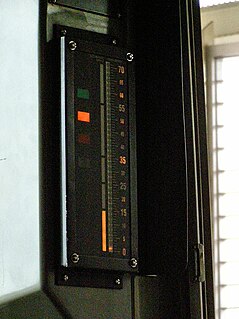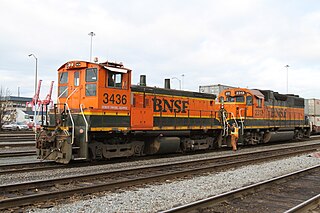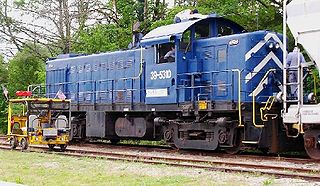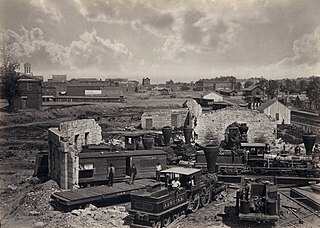 W
WA locomotive or engine is a rail transport vehicle that provides the motive power for a train. If a locomotive is capable of carrying a payload, it is usually rather referred to as a multiple unit, motor coach, railcar or power car; the use of these self-propelled vehicles is increasingly common for passenger trains, but rare for freight.
 W
WAn internal combustion locomotive is a type of railway locomotive that produces its pulling power using an internal combustion engine. These locomotives are fuelled by burning fossil fuels, most commonly oil or gasoline, to produce rotational power which is transmitted to the locomotive's driving wheels by various direct or indirect transmission mechanisms. The fuel is carried on the locomotive.
 W
WA Bahnbetriebswerk is the equivalent of a locomotive depot on the German and Austrian railways. It is an installation that carries out the maintenance, minor repairs, refuelling and cleaning of locomotives and other motive power. In addition it organises the deployment of locomotives and crews. In the Deutsche Bahn, a Bahnbetriebswerk is known today as a Betriebshof; the ÖBB refer to it as a Zugförderungsstelle (Zf). Many other countries simply use the term 'depot'. The smaller facility, the Lokomotivstation akin to the British sub-depot or stabling point, is affiliated to a Bahnbetriebswerk.
 W
WCab signaling is a railway safety system that communicates track status and condition information to the cab, crew compartment or driver's compartment of a locomotive, railcar or multiple unit. The information is continually updated giving an easy to read display to the train driver or engine driver.
 W
WIn rail transport, distributed power (DP) is a generic term referring to the physical distribution—at intermediate points throughout the length of a train—of separate motive power groups. Such 'groups' may be single units or multiple consists, and are remotely controlled from the leading locomotive. The practice allows locomotives to be placed anywhere within the length of a train when standard multiple-unit (MU) operation is impossible or impractical. DP can be achieved by wireless or wired (trainlined) means. Wired systems now provided by various suppliers use the cabling already extant throughout an ECP train.
 W
WA dock shunter, or "dock tank", is a locomotive used for shunting wagons in the vicinity of docks. It is usually of 0-4-0 or 0-6-0 wheel arrangement and has a short wheelbase and large buffers. These features make it suitable for negotiating sharp curves.
 W
WAn electric locomotive is a locomotive powered by electricity from overhead lines, a third rail or on-board energy storage such as a battery or a supercapacitor.
 W
WA gas turbine locomotive is a type of railway locomotive in which the prime mover is a gas turbine. Several types of gas turbine locomotive have been developed, differing mainly in the means by which mechanical power is conveyed to the driving wheels (drivers). A gas turbine train typically consists of two power cars, and one or more intermediate passenger cars.
 W
WA heritage unit is a railroad locomotive painted in an honorary paint scheme; usually the paint scheme of a now-defunct railroad that merged with or was acquired by the locomotive's owner. The Union Pacific Railroad painted six EMD SD70ACes in stylized paint schemes of six of its predecessors between 2005 and 2006. The Norfolk Southern Railway did the same in 2012 with 20 of its locomotives. 10 of them being EMD SD70ACes, while the others being GE ES44AC units. For its 40th anniversary in 2011, Amtrak painted 4 GE P42DCs, a P40DC, and an EMD F40PH converted to an NPCU into its older paint schemes. In late 2020, the Canadian National Railway revealed five new heritage units after they had been first spotted a month earlier. These included four GE ET44ACs and one EMD SD70M-2.
 W
WLocotrol is a product of GE Transportation that permits railway locomotives to be distributed throughout the length of a train. It is installed on more than 8,500 locomotives around the world, sending signals from the lead locomotive and via radio to the remote control locomotives.
 W
WThe motive power depot is the place where locomotives are usually housed, repaired and maintained when not being used. They were originally known as "running sheds", "engine sheds" or, for short, just sheds. Facilities are provided for refuelling and replenishing water, lubricating oil and grease and, for steam engines, disposal of the ash. There are often workshops for day to day repairs and maintenance, although locomotive building and major overhauls are usually carried out in the locomotive works.
 W
WA remote control locomotive is a railway locomotive that can be operated with a remote control. It differs from a conventional locomotive in that a remote control system has been installed in one or more locomotives within the train, which uses either a mechanical or radio transmitter and receiver system. The locomotive is operated by a person not physically located at the controls within the confines of the locomotive cab. They have been in use for many years in the railroad industry, including industrial applications such as bulk material load-out, manufacturing, process and industrial switching. The systems are designed to be fail-safe so that if communication is lost the locomotive is brought to a stop automatically.
 W
WA road switcher is a type of railroad locomotive designed to both haul railcars in mainline service and shunt them in railroad yards. Both type and term are North American in origin, although similar types have been used elsewhere.
 W
WA streamliner is a vehicle incorporating streamlining in a shape providing reduced air resistance. The term is applied to high-speed railway trainsets of the 1930s to 1950s, and to their successor "bullet trains". Less commonly, the term is applied to fully faired recumbent bicycles. As part of the Streamline Moderne trend, the term was applied to passenger cars, trucks, and other types of light-, medium-, or heavy-duty vehicles, but now vehicle streamlining is so prevalent that it is not an outstanding characteristic. In land speed racing, it is a term applied to the long, slender, custom built, high-speed vehicles with enclosed wheels.
 W
WA switcher, shunter, yard pilot, switch engine, yard goat, or shifter is a small railroad locomotive used for manoeuvring railroad cars inside a rail yard in a process known as switching (US) or shunting (UK). Switchers are not intended for moving trains over long distances but rather for assembling trains in order for another locomotive to take over. They do this in classification yards. Switchers may also make short transfer runs and even be the only motive power on branch lines and switching and terminal railroads. The term can also be used to describe the workers operating these engines or engaged in directing shunting operations.
 W
WThe Tiger Stripes colour scheme is a pattern of painting applied to locomotives to improve visibility. It entails painting the whole locomotive bright yellow, and adding diagonal black stripes to the front and back. It is called 'Tiger Stripes' because of its resemblance to the stripes of a tiger.
 W
WA tram engine is a steam locomotive specially built, or modified, to work on a street, or roadside, tramway.
 W
W W
W